Melaleuca acacioides
Melaleuca acacioides, commonly known as coastal paperbark[3] and as lunyamad by the Bardi people,[4] is a plant in the myrtle family, Myrtaceae and is native to the northern parts of the Northern Territory, Cape York Peninsula and New Guinea. It is closely related to Melaleuca alsophila and Melaleuca citrolens, being differentiated from them by the number of flowers in a group. In this species, they are in groups of three (called triads). It is a small to medium-sized tree, sometimes with several trunks when growing in the open. It usually grows in areas with saline soils that are regularly flooded, often near mangroves.
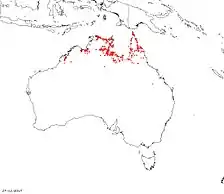
| Coastal paperbark | |
|---|---|
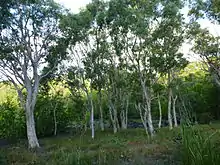 | |
| Melaleuca acacioides near mangroves and Cooktown Cemetery, Queensland | |
| Scientific classification | |
| Kingdom: | Plantae |
| Clade: | Tracheophytes |
| Clade: | Angiosperms |
| Clade: | Eudicots |
| Clade: | Rosids |
| Order: | Myrtales |
| Family: | Myrtaceae |
| Genus: | Melaleuca |
| Species: | M. acacioides |
| Binomial name | |
| Melaleuca acacioides | |
| Synonyms[2] | |
Description
Melaleuca acacioides is a tree, usually with white or grey papery bark, sometimes growing as high as 10 m (30 ft). The young growth is covered with rather long, soft hairs. Its leaves are arranged alternately on the stems, and are 23–70 mm (0.9–3 in) long and 6–14 mm (0.2–0.6 in) wide, glabrous when mature, narrow oval in shape, sometimes with a small point on the end and with many distinct oil glands.[5]
The flowers are white to cream and arranged in spikes, sometimes at the tips of the branches and sometimes in the leaf axils. Each spike contains 2 to 10 groups of flowers in threes. The stamens are arranged in five bundles around the flower and each bundle contains 6 or 7 stamens. Flowers appear in winter and spring and are followed by woody capsules 1.6–2.3 mm (0.06–0.09 in) long grouped in clusters along the stem.[5][6]
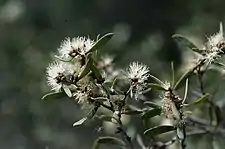
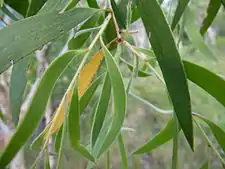
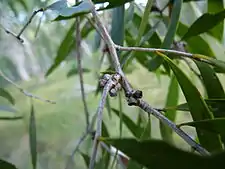
Taxonomy and naming
Melaleuca acacioides was first described in 1862 by Ferdinand von Mueller in Fragmenta Phytographiae Australiae.[7][8] The specific epithet (acacioides) is a reference to the similarity of the leaves to those of some Acacia species.[5] The ending -oides is a Latin suffix meaning "resembling" or "having the form of".[9]
In 1986, the genus Melaleuca was reviewed by Bryan Barlow and Melaleuca acacioides was separated into three groups - a new species, Melaleuca citrolens and two subspecies:[10]
Distribution and habitat
Melaleuca acacioides occurs from western Arnhem Land in the Northern Territory to Cape York Peninsula and New Guinea. It grows on the landward side of mangroves and samphire in slightly saline soils.[5]
Uses
Traditional uses
Aboriginal people used the leaves of Melaleuca acacioides (and of M. argentea and M. leucadendra) as flavouring in cooking. "Bee bread" (produced from pollen) and honey were foods collected from native bee hives prevalent in swamp forests, including those of Melaleuca acacioides.[13][14]
References
- "Melaleuca acacioides". World Checklist of Selected Plant Families (WCSP). Royal Botanic Gardens, Kew.
- Craven, Lyndley A.; Lepschi, Brendan J. (1999). "Enumeration of the species and infraspecific taxa of Melaleuca (Myrtaceae) occurring in Australia and Tasmania". Australian Systematic Botany. 12 (6): 819–928. doi:10.1071/SB98019.
- "Melaleuca acacioides". FloraBase. Western Australian Government Department of Parks and Wildlife.
- Smith, Moya; Kalotas, Arpad C. (1985). "Bardi Plants: An Annotated List of Plants and Their Use by the Bardi Aborigines of Dampierland, in North-western Australia" (PDF). Records of the Western Australian Museum. 12 (3): 356. Retrieved 30 August 2015.
- Brophy, Joseph J.; Craven, Lyndley A.; Doran, John C. (2013). Melaleucas : their botany, essential oils and uses (PDF). Canberra: Australian Centre for International Agricultural Research. p. 65. ISBN 9781922137517. Retrieved 30 August 2015.
- Holliday, Ivan (2004). Melaleucas : a field and garden guide (2nd ed.). Frenchs Forest, N.S.W.: Reed New Holland Publishers. p. 14. ISBN 1876334983.
- "Melaleuca acacioides". APNI. Retrieved 23 July 2015.
- von Mueller, Ferdinand (1862). Fragmenta Phytographiae Australiae (Volume 3). Melbourne. p. 116. Retrieved 9 August 2015.
- Brown, Roland Wilbur (1956). The Composition of Scientific Words. Washington, D.C.: Smithsonian Institution Press. p. 483.
- Barlow, Bryan A. (1986). "Contributions to a revision of Melaleuca (Myrtaceae): 1—3". Australian Systematic Botany. 9 (2): 163. doi:10.1071/BRU9860163. Retrieved 3 March 2015.
- "Melaleuca acacioides subsp.acacioides". APNI. Retrieved 26 July 2015.
- "Melaleuca acacioides subsp. alsophila". APNI. Retrieved 26 July 2015.
- Brophy, Joseph J.; Craven, Lyndley A.; Doran, John C. (2013). Melaleucas : their botany, essential oils and uses (PDF). Canberra: Australian Centre for International Agricultural Research. p. 33. ISBN 9781922137517. Archived from the original (PDF) on 28 May 2015. Retrieved 3 March 2015.
- Williams, Cheryll (2010). Medicinal plants in Australia. Kenthurst, N.S.W.: Rosenberg Publishing. p. 200. ISBN 9781877058790. Retrieved 7 April 2015.
- Southwell, Ian; Lowe, Robert (1999). Tea Tree the Genus Melaleuca. London: CRC Press. p. 241. ISBN 0203303601. Retrieved 25 July 2015.
- Maiden, Joseph Henry (1889). The Useful Native Plants of Australia. Ludgate Hill: Trubner and Co. p. 568. Retrieved 30 August 2015.